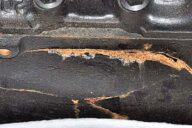Capt. John of skippertips.com has tips on how to protect your hull when docking in less than ideal conditions.
Imagine that you need to tie up alongside a pier full of crusty, razor-sharp barnacles that cover the surface of the pilings. Or maybe you need to lie next to a stone or concrete seawall. What little-known option will protect your hull, be a lot more effective than a line of fenders and provide peace-of-mind when cruising or sailing? Follow these easy sailing tips to protect your expensive sailboat from damage this sailing season!
Hang fenders in a vertical position when you need to tie up alongside a flush seawall or pier. Vertical fenders lose their effectiveness inside a slip. They can roll off of a piling as the tide rises and falls or the boat moves about on slack docking lines. Turn fenders horizontal to spread the surface area a bit more inside a slip or along irregular pier faces. But there’s another option that provides unbroken surface protection over a large area.

Use a fender board anytime you need maximum protection. The fenderboard takes the brunt of the chafing, grating, grinding or rubbing when docked alongside irregular, dirty surfaces. Just the fenderboard makes contact with the pier or seawall. Two to three fenders are hung on the inside of the fenderboard. With this arrangement, your hull will not come into contact with the pier or seawall.
The fenderboard provides complete protection across the width of the board. Practical Sailor magazine recommends the lumber dimensions shown in the illustration (right). Use marine grade plywood for strength and integrity. Follow the steps below to make a fenderboard for your specific boat based on her length.

How to Build a Fenderboard Fast ‘n Easy
1. Buy a piece of marine plywood or similar lumber based on the specifications in the table above. Feel free to customize these measurements as desired. Drill a hole into each end of the fenderboard (top illustration) Make the hole just large enough to accept the diameter of the specific line you intend to use to hang your fenderboard.
2. Thread long lengths of line (at least four feet long) through each hole as shown (top illustration). Whip the ends of the line to prevent fraying. Tie a thick knot into the end of the line where they exit the bottom of your board. Use a bulky knot like a figure-8 or double-overhand knot to anchor the line in place.
3.Tie two to three fenders to your boat across the area you desire to protect. Drape the fenderboard onto the outside of the tied-off fenders (middle and bottom illustrations). Belay the fenderboard lines to strong cleats or robust deck fittings (do not use lifelines!). Adjust the lines to keep the fenderboard centered on the fenders.
~~~~~~~~~~~~~~~~~~~~
Captain John’s Sailing Tip
For smaller sailboats or for those that need the ultimate in lightweight material, use PVC tubing instead of lumber. Cement PVC pipe caps onto each end of a four-foot piece of large diameter PVC tube. Drill holes near the ends of the tube. Thread four-foot pieces of line through each hole. Knot one end to anchor the line to the bottom of the PVC tube.
~~~~~~~~~~~~~~~~~~~~
Follow these easy sailing tips to keep your expensive sailboat hull free of scratches, chips, or gouges when docked alongside a pier, seawall, quay or other structure. This will provide worry-free protection for your small sailboat for many sailing seasons to come!












